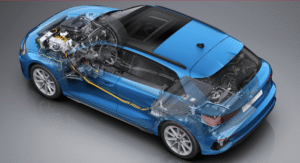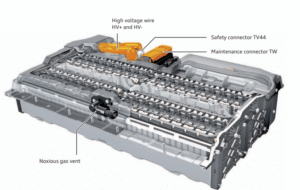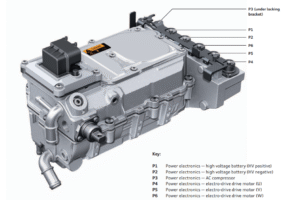Tagged: Technology, Vehicles
-
AuthorPosts
-
🚗 Hybrid vehicle Problems and Systems: The Ultimate Guide to Components, Working, and Troubleshooting
Hybrid vehicles
Hybrid vehicles are automobiles that combine two or more power sources, typically a gasoline engine and an electric motor, to improve fuel efficiency and reduce emissions. Here’s a detailed breakdown
🔍 What is a Hybrid Vehicle System?
A hybrid vehicle system combines two power sources—typically a petrol or diesel internal combustion engine (ICE) and an electric motor. Together, they improve fuel economy, reduce emissions, and deliver smoother driving performance.
Popular models like the Toyota Prius, Audi A6/A8, and BMW 330e use advanced hybrid technologies that automatically switch between electric and engine power depending on driving conditions.
⚙️ Types of Hybrid Systems
Understanding the different types of hybrid systems is key to identifying Hybrid vehicle Problems and choosing the right hybrid car repair approach.
1. Mild Hybrid (MHEV)
- Assists the engine with a small electric motor
- Cannot drive using electric power alone
2. Full Hybrid (HEV)
- Can drive using electric-only mode or a mix of engine and motor
- Example: Toyota Prius
3. Plug-in Hybrid (PHEV)
- Comes with a larger battery, rechargeable externally
- Example: BMW 330e, Audi Q5 PHEV
🧩 Key Components of a Hybrid Car System
Every hybrid car system includes the following components:
Component Function Internal Combustion Engine Provides power during high loads or highway speeds Electric Motor (E-Machine) Powers the car in EV mode and assists in acceleration High-Voltage Battery Stores energy for the electric motor (typically 200–400V) Inverter/Converter (PCU) Manages energy flow between the battery, motor, and engine Regenerative Braking Converts braking energy into electric charge Hybrid Control ECU Controls hybrid operation and monitors system status Cooling System Keeps battery and electronics at safe temperatures Safety Components Includes insulation monitors, fuses, and disconnects [caption id="attachment_4057" align="alignnone" width="300"]
 Hybrid vehicle Problems.[/caption]
Hybrid vehicle Problems.[/caption]hybrid vehicles advantages
🚘 1. Better Fuel Efficiency
Hybrid vehicles combine a gasoline engine with an electric motor, allowing them to use less fuel — especially in city driving or stop-and-go traffic.
💰 2. Lower Running Costs
Thanks to improved fuel economy and regenerative braking, hybrids help reduce fuel expenses and brake wear over time.
🌍 3. Environmentally Friendly
Hybrid vehicles emit less CO₂ and pollutants, making them a more eco-conscious choice than conventional gasoline cars.
🔇 4. Quiet and Smooth Driving
When running on electric power, hybrids are nearly silent. This creates a quieter and smoother driving experience.
⚡ 5. Regenerative Braking
Energy usually lost during braking is captured and stored in the battery, increasing efficiency and reducing wear on the braking system.
🛠️ 6. Less Engine Wear
Since hybrids rely on electric motors at low speeds, the gasoline engine experiences less strain, potentially extending its lifespan.
🏷️ 7. Government Incentives
Many countries offer tax breaks, rebates, and access to restricted zones for hybrid vehicles, lowering the overall cost of ownership.
🚦 8. Ideal for Urban Driving
Hybrid cars often operate in electric-only mode at low speeds, which makes them perfect for cities with frequent traffic lights and congestion.
⚡ How Does a Hybrid System Work?
Hybrid vehicles operate using different modes depending on speed and driving demands:
- EV Mode (Electric-Only): Powers the vehicle at low speeds (0–50 km/h)
- Engine Mode: Engages the internal combustion engine for high-speed driving
- Hybrid Mode: Combines both power sources for optimal performance
- Regenerative Braking: Converts kinetic energy into battery charge
- Start-Stop Function: Turns off the engine during idling to save fuel
❗ Common Hybrid vehicle Problems.
Modern hybrids are efficient—but they’re not problem-free. Here are the most common Hybrid vehicle Problems
Problem Likely Cause Car won’t start HV battery depleted or safety disconnect engaged EV mode not working Low battery charge or abnormal temperature Warning lights appear Faulty sensor, inverter issue, or poor insulation Reduced performance Battery or cooling system inefficiency Overheating Faulty fan or cooling circuit for battery/motor These issues are often seen in models like the Toyota hybrid system malfunction error or the hybrid system warning light on Audi and Honda hybrids.
🧰 How to Repair and Diagnose Hybrid Systems
Here’s a step-by-step hybrid diagnostic guide for both professionals and DIYers:
- Check the instrument panel for error codes or hybrid fault warnings
- Connect an OEM diagnostic tool (e.g., ODIS, Techstream, or HDS)
- Inspect HV battery state of charge (SOC) and internal resistance
- Test insulation with an HV tester like VAS 6558A
- Check all connectors for corrosion or heat damage
- Scan for inverter or motor issues (common hybrid battery problems)
- Replace or repair faulty parts based on diagnostic trouble codes (DTCs)
- Confirm normal operation in EV, hybrid, and engine modes
[caption id="attachment_4060" align="alignnone" width="300"]
 hybrid vehicles battery problems[/caption]
hybrid vehicles battery problems[/caption]
🔍 How to Identify a Faulty Hybrid Component
To find out which part of the hybrid system is malfunctioning:
- Use diagnostics to read DTCs (e.g., P0A80, P0A1F)
- Observe live data for motor RPM, battery voltage, temperature, and inverter status
- Test insulation resistance in high-voltage wiring
- Check fuses and contactors in the power electronics
- Validate sensor data like G712 (temperature) and G713 (motor position)
[caption id="attachment_4061" align="alignnone" width="300"]
 hybrid vehicles inverter[/caption]
hybrid vehicles inverter[/caption]
🛠️ Tools Required for Hybrid vehicle Service
Working safely with hybrids requires the right equipment:
Tool Purpose Diagnostic Scanner (ODIS, Techstream) Read and clear hybrid DTCs Insulated Gloves (Class 0 or higher) Prevent electric shock during service HV Tester (VAS 6558A) Measure high-voltage system insulation and voltage Isolation Box (VAS 6606) Safely deactivate HV circuits before repair CAT III Multimeter Check circuits rated up to 1000V Connector Tool Set (e.g., T40258) Disconnect HV plugs safely OEM Service Manual Locate test points, wiring diagrams, and torque specs ⚠️ Always follow manufacturer guidelines and wear PPE when working on high-voltage systems.
✅ Final Words
Hybrid systems are the future—but they need expert handling. By learning how these systems function, what tools to use, and how to read their signals, you can:
- Catch Hybrid vehicle Problems early
- Avoid expensive repairs
- Extend your car’s lifespan and performance
Whether you’re a technician, DIY car enthusiast, or simply a hybrid vehicle owner, this guide helps you stay prepared and confident in handling hybrid system faults.
💬 Got questions or facing hybrid issues?
Join our forum or FB-Page and discuss with hybrid experts, technicians, and fellow car owners. -
AuthorPosts
- You must be logged in to reply to this topic.
